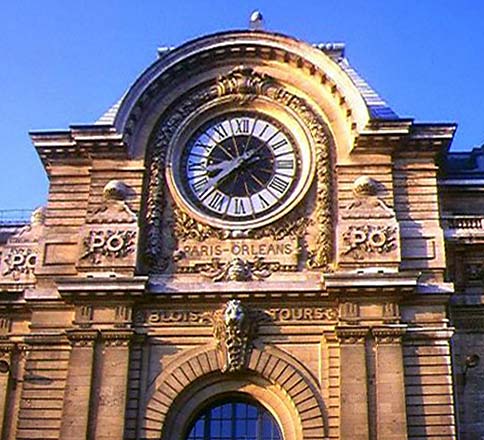About Musee d'Orsay
The Musée d'Orsay is a national museum which opened to the public in December 1986 in order to show, in all its diversity, the artistic creation of the western world from 1848 to 1914. THE COLLECTIONS
Paintings and Pastels
Ground Floor
The paintings are both organised chronologically and grouped according to aesthetic currents, so as not to break up certain important private collections which have helped complete throughout the twentieth century the official acquisitions of the former Musée du Luxembourg.
The ground floor is devoted to the period up until the beginning of the 1870's.
The galleries on the right present the evolution of history painting showing later works by Ingres, Delacroix and Chassériau and provide the transition to academic painting (Cabanel) and to Degas' débuts, as well as to Couture, Puvis de Chavannes and Gustave Moreau, these last two setting the stage for Symbolism.
The galleries on the left house the Chauchard collection, centered around Millet's Angelus, and display Corot and the Naturalist tendencies of the Barbizon School. The latter provide a prelude to the Realist movement which emerged under the Second Republic (Rosa Bonheur, Antigna) and which imposed itself with Courbet, soon to be followed by Manet and the future Impressionists, whose first works are presented here. The Mollard and Personnaz collections demonstrate the taste of amateurs for the Impressionists and their friends.
Upper Level
On the top floor, the Moreau-Né1aton collection presented in the first gallery is dominated by Manet's Déjeuner sur l'herbe, masterpiece of the 1863 Salon des Refusés.
The next rooms in the Galerie des Hauteurs are devoted to Manet and Whistler and to the spread of Impressionism at the time of the group exhibitions with Degas, Monet, Renoir, Pissarro, Sisley and Caillebotte, painter and patron whose bequest in 1897 brought a large number of works of his friends into the Musée du Luxembourg. Following the galleries devoted to Monet and Renoir after 1880 come Cézanne and Van Gogh, displayed together as they both come from the Gachet collection.
Sculpture
In spite of an exceptional volume of production, nineteenth-century sculpture was neglected during a large part of the twentieth century. Today, under the changing light of the Musée d'Orsay's glass vault, the sculptors of the first half of the 19th century, Rude, David d'Angers, Pradier, Préault and Barye, open the museum's circuit. While the latter two lived well into the third quarter of the century, the others passed away in the 1850's, after having trained the following generations.
Daumier is an avant-garde sculptor, and the Célébrités du Juste Milieu of 1831-1853 naturally open the realist circuit in the Musée d'Orsay on the Seine side, while Cartier-Belleuse, Cavelier, Clesinger, Cordier, Delaplanche, Dubois, Guillaume, Falguière and Mercié illustrate eclecticism on the opposite side and in the central alley.
Carpeaux, under the influence of Michelangelo, expended his feverish, nervous energy on large-scale façades, thanks to the official commissions which demonstrate the economic prosperity of the Second Empire. Plaster models of many of his works are assembled around The Dance, a stone sculpture which originally decorated the façade of the Opéra Garnier.
In the Galerie des Hauteurs on the top floor, Degas' rigourous research in sculpture is displayed, in which "l'à peu près n'est pas de mise" ("almost' is unacceptable") and Gauguin paves the way for Symbolism and Primitivism.
Architecture
The Musée d'Orsay has dedicated several exhibition spaces, designed by the scenographer Richard Peduzzi, to architecture.
In the Opera gallery, the works displayed evoke the architecture and decor of the new Opéra, built between 1861 and 1875 by Charles Garnier. One can see painted sketches, models of sculptures and of other elements of the decor (on loan from the architectural agency of the Opera), a model of the stage, built for the World Fair of 1900 (on loan from the Musée de l'Opéra), and the longitudinal cross-section of the Opéra as it appeared in 1875 for its inauguration. Models of the Opéra's decor from the collections of the Musée de l'Opéra are exhibited on a rotating basis. Presented beneath a glass floor, the 1/1000 scale model of the Opéra's neighbourhood in 1914 situates the monument in its urban context.
The Musee d’Orsay
The Musee d’Orsay, scenically located on the left bank of the Seine, is a museum and gallery housing (mainly French) works of art from between 1848 and 1914. Despite this relatively constrictive timescale, the period was one of great developments in French painting and sculptur.
Including Impressionism, which are reflected in some of the truly exquisite works of art on display at the Musee d’Orsay.
The museum opened in 1986, after 9 years of planning. The former Gare d’Orsay (a railway station) is its home- a splendid structure in its own right and one which was saved from demolition as a good example of late 19th and early 20th century architecture.
Each year almost 3 million people come to the museum.
The collection on offer shows why. Amongst others, the brilliant Rodin and Gauguin have sculptures on display, and the work by French artists reads like an entry in French painting’s hall of fame. Van Gogh, Renoir, Cezanne, Seurat, Monet, Degas and Pisarro (to name but a few) have work displayed at the gallery; and there are also pieces from “foreign” painters of the time, like Whistler, too.
Much of the work comes from collections formerly held at The Louvre and the Musee du Jeu de Paume. It also purchases new items frequently for its collection, which each attraction adding to the appeal of the museum.
Admission is a very reasonable 8 euros for a standard ticket, which is great value for money.







No comments:
Post a Comment